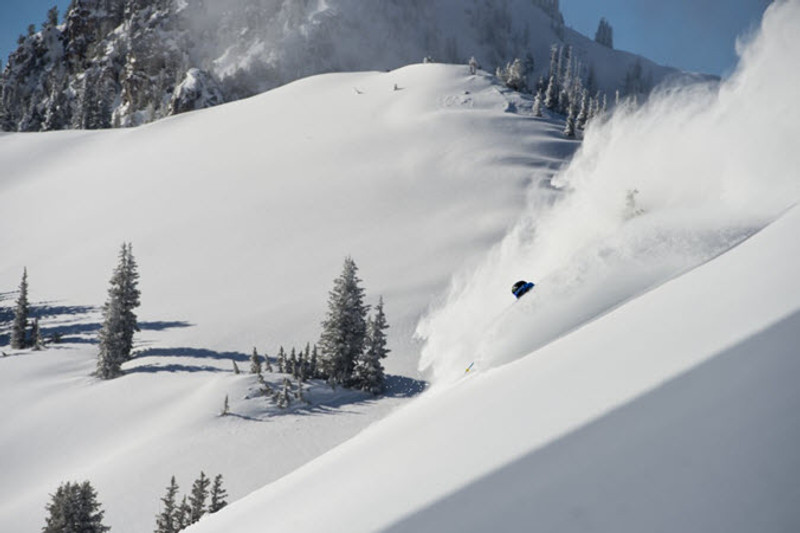Alta Ski Area is known as one of the snowiest places in the country, getting an average of 551 inches of snow each year. -Photo courtesy of Alta
Lots of ski resorts like to brag about their snow. But if deep powder that skis like nothing you have ever experienced before is what you crave, there’s no better place in the country than Alta, located just outside of Salt Lake City, Utah. The state of Utah uses the slogan the Greatest Snow on Earth™, and Alta epitomizes that bold claim. In both quality and quantity, Alta consistently delivers.
Alta is located in Little Cottonwood Canyon, one of the snowiest places on the planet, receiving an average of 551 inches of snow each year. During ski season, that means more than a foot of snow every five days. In addition to the volume of snow, the quality is just what you want for skiing. Why? The climate conditions in the area generate a snow density of 8.5 percent. That probably doesn’t mean much to anyone who didn’t study meteorology, but it means that the snow has the just the right consistency for your skis to float through the powder. For skiers, the light, fluffy snow has a softer feel, which is why anyone who loves powder skiing should flock to Utah.
The mountains may get more than 40 feet of snow a year, but Salt Lake City, which is only 40 minutes away, gets about five. That means travel to and from the resorts is typically easy. You can enjoy the fresh powder at Alta and still travel to Salt Lake City’s amenities at night.
What Makes It Great?
[embed]https://www.instagram.com/p/BRZkA9lBGVk/[/embed]
So what is it about this section of Utah that makes the snow just right? According to Jim Steenburgh, an atmospheric scientist at the University of Utah, it’s the location of Alta in the Wasatch Mountains. One of the reasons for the frequent storms is that the Great Salt Lake doesn’t freeze.
Storms develop in the Pacific Ocean and head toward the Sierra Nevada Mountains. There, storms drops snow with 10 percent to 12 percent moisture density. The clouds dry out as they head east to Utah, and the snow moisture density decreases to 8.5 percent. As it crosses the Great Salt Lake, the storms get colder and drier. This causes the snowfall to leave a slightly denser base at the bottom, and a fluffier lighter layer of snow on top.
Under these conditions, a light crystal-type of snowflake called a dendrite is produced. They are thin and symmetrical in shape, but most importantly for skiers, they create fluffy powder that’s perfect for skiing.
In a sense, Alta’s snow can be boiled down to a single word: flotation. Excellent flotation is defined by a formula that examines snow water content and conditions that cause lighter snow to fall on heavier snow. You can see the benefits in all the pictures and video you see of skiers and riders kicking up knee-deep Utah snow. Best of all, days of prime flotation are not an exception, but a rule.
Steenburgh explains that flotation exists when light snow has enough body, or is "bottomless," to keep skis on the upper layer of snow without scraping the base. To achieve this, snowstorms must be frequent and ample, but not too often. It is possible to have too much of a good thing, and Steenburgh calls the perfect frequency and strength of storms that produce quality deep-powder "Goldilocks storms," which feature "just right" conditions. More often than not, things go right in Utah. The Wasatch Mountain Range is world-renowned for its skiing because Utah enjoys these frequent and predictable storms.
Not only do you get that high-quality snow, but it starts early and lasts long. On average, Alta gets 6.7 feet of snow each April, making it one of the best spring skiing destinations in the country.
[embed]https://www.instagram.com/p/BUz79DiFLRs/[/embed]
The area around Alta averages 40 snow events a year, which means that you have lots of opportunity for fresh powder. But it also features 18 snowstorms a year that include 12 inches of snow or more in a 24 hour period. That means that there’s a good chance you’ll have an opportunity for a snorkel-deep day of skiing on a trip to Alta.
If the science of snow interests you, make sure to Steenburgh’s book, Secrets of the Greatest Snow on Earth: Weather, Climate Change, and Finding Deep Powder in Utah's Wasatch Mountains and around the World.
For the rest of us, it may be enough to enjoy first-hand some of the best skiing in the world. While you may be able to find one or two places with more snow each winter, there’s nowhere else that combines the quantity and quality of Alta. See for yourself why so many people make it their go-to destination every year.
Written by Jeff Banowetz for RootsRated in partnership with Alta Ski Area and legally licensed through the Matcha publisher network. Featured image provided by Photo courtesy of Alta.
Recent Posts
How to Ski on a Budget?
When to Replace Your Ski Equipment?
Utah Yurt Trips 101: How To Plan and Where To Go.

